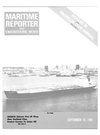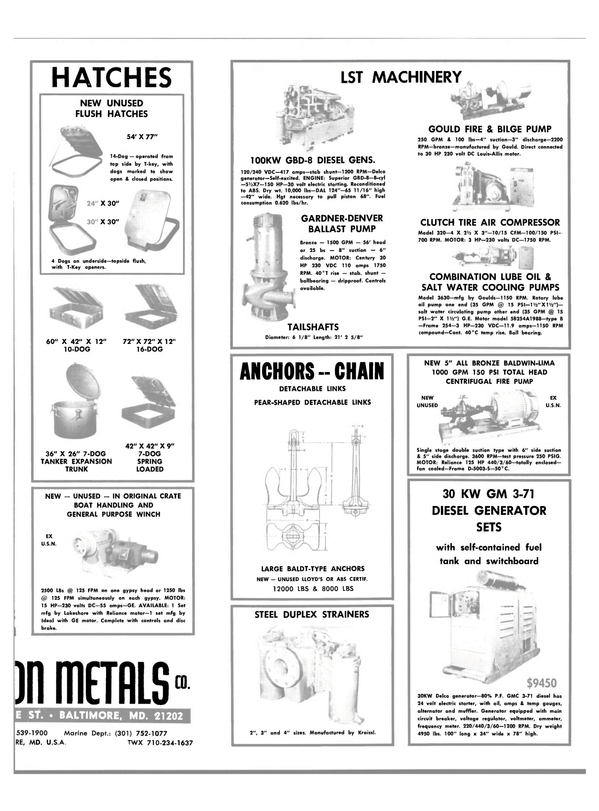
Vancouver Shipyards Launches Log Barge On A Film Of Water
The building capabilities of some shipyards are hampered by the problems involved in moving a launch-ready hull across dry land to the ways.
For Vancouver Shipyards Co., Ltd., North Vancouver, British Columbia, the solution has been to use "water bearings" to float the hull across land on a .005-inch film of water. In so doing, the yard has expanded its capability from a vessel size of 270 feet and 1,200 tons to a present maximum of 500 feet and 9,000 tons.
In addition, the water bearings allow the company to build several larger ships simultaneously.
"With the water bearing system that we now use for this purpose, we can have several ships at various stages of construction," according to Ken Davies, naval architect for the firm.
The company's first major use of water bearings to position a large ship for launch took place in 1975, with the transfer of a 457-foot-long, 3,500-ton ferry for the provincial government. The most recent use of the system took place when the yard launched the first barge to be designed specifically to carry bundled logs. That barge, the Seaspan Rigger, will cost $11 million when completed. The barge has an overall length of 120 meters (about 394 feet), molded breadth of 27 meters (89 feet), and cargo deadweight of 12,700 tons. The barge is intended to serve major forest companies around the Queen Charlotte Islands, off the west coast of Canada, and Vancouver Island.
As with the ferry and other vessels similarly launched, the barge was moved from its building berth across to the launch sleds for side launching, using water bearings or "casters" supplied by Aero-Go, Inc., of Seattle, Wash. The launch weight of the Seaspan Rigger was 3,000 tons.
Water bearings are basically the same design as the air bearings developed over 15 years ago by Aero-Go. The major difference between the two systems is that the water bearings employ a thin (.005-inch) film of water instead of air on which the load moves, almost free of friction. In the launching of the Seaspan Rigger barge, the cradle of the barge moved on 96 Aero-Caster water bearings in carrying the ready-tolaunch vessel 150 feet to the launch sleds.
Each inflatable 48-inch by 48-inch caster has a circular element, or torus bag, permanently bonded to a rigid backing plate.
The bag is donut shaped, forming a central plenum chamber inside. There are also corner and center "landing pads" to support the load when the element is not inflated.
For lifting and moving, water is pumped into the bearing at a pressure of 50 psi. As soon as pressure within the caster exceeds the load's weight above it, the water escapes very gradually under the flexible bottom face, raising the load about .005 inch over the surface, which in this case is one of a number of concrete runways. The result is that the load floats above the surface so that approximately 1,000 pounds of load can be moved with only one pound of force.
Because the load can be moved with equal ease in any direction, work can be scheduled with great flexibility, Mr. Davies points out.
"We can build ship modules under cover, move them past one another on the building berth if required, and adjust to unforeseen schedule changes under circumstances such as delays caused by special supply problems." In the handling of the 3,000-ton log barge, the cradles on which the hull rested were sets of blocks, each 50-feet long. These in turn rested on wood spacers holding the blocks 2 inches above the concrete runways.
This provided space for the insertion of the Aero-Caster bearings approximately one week before moving time to allow hookup of the water system. It took only two hours to place the water bearings and a week to install pipe manifolds and hoses. The yard used 3-inch-diameter pipe for the manifolds and 100-foot-long hoses from the service pits to the manifolds, with smaller hoses between the manifolds and the casters.
A crew inflated the water bearings, which lifted the blocks approximately 4 inches above the concrete runners. Motive power and guidance were provided by six crawler cats, two pushing and two braking, with one at each end to control movement fore and aft. "The vessel was also kept on line by a series of guide rollers attached to the launch cribs and acting on the sides of the concrete runways and launch sleds. We also had a 10-man crew on the ground including supervisors standing by." The excess water from the bearings was no problem, Mr.
Davies adds, since it also kept the runways clean and simply drained off into the ground.
Read Vancouver Shipyards Launches Log Barge On A Film Of Water in Pdf, Flash or Html5 edition of September 15, 1981 Maritime Reporter
Other stories from September 15, 1981 issue
Content
- Two Vessels Trucked To 'Sea' page: 5
- Navy Buys Six SL-7 Sea-Land Containerships In $207.5-Million Contract page: 7
- $5-Million Contract To Burrard Yarrows For Vessel Lengthening page: 8
- NASSCO Delivers First Of Three New Carlsbad Class Product Carriers To Union Oil page: 8
- Bartell Named GM Of Texaco's International Marine Sales Department page: 9
- Amsterdam Drydock To Rebuild Ro/Ro Passenger Vessel For Irish Line page: 9
- Dravo SteelShip Delivers The 'Bud Weber' page: 10
- NASSCO Lays Keel Of 44,000-Dwt Product Carrier For American Trading page: 10
- OCEANS 81 page: 12
- Gibbs & Cox Names Ford Chief Engineer page: 16
- Literature Available On Devflex 1, Fire Retardant Finish From Devoe Marine page: 16
- John Chandler Named York Vice President page: 18
- Announce Personnel Changes In Marine Branch At Phillips page: 18
- Griffin-Alexander III Commissioned At Beth Baltimore page: 20
- Skully Bros. Delivers Omaha Arrow, Second Of Six Supply Vessels page: 24
- Iowa Marine Delivers M/V Tony H page: 24
- Curtis S. Townshend Appointed Vice President Of Mobil Marine Sales page: 25
- Lease MARISAT Satellites For Use In Three Oceans page: 25
- 55th Annual PROPELLER CLUB CONVENTION page: 26
- Bayou Black Shipyard, Inc. Delivers 'Delta Christie' page: 34
- HBC Barge Installs New Launchways-First Phase In $4-Million Expansion page: 34
- Name O'Leary Marine Development Manager At Dillingham Ocean page: 36
- Tracor Marine Announces Production Appointments At Port Everglades Yard page: 38
- Literature Available From Gems Sensors On New Flow Transducer page: 38
- Vancouver Shipyards Launches Log Barge On A Film Of Water page: 41
- N e w V e r s i o n O f N a t i o n a l S u p p l y J a c k i n g System — L i t e r a t u r e A v a i l a b le page: 50
- Anschuetz Hosts Exhibit For Major Manufacturers Of Marine Equipment page: 52
- 'Petromar Bravo# Delivered By Halter —Third Of Six Ordered page: 52
- Launch Two Stern Trawlers At Halifax page: 54
- IHI To Employ New Hull Form On 223,000-Dwt Bulk Carrier page: 55
- Levingston, CNC Sign Agreement To Build Jackups At La Ciotat page: 56
- Seaward International Opens New York Office page: 56
- W h e e l e r Associates Names W a r y a s A Vice President page: 58
- 'Gulf Shark' Delivered To Gulf Fleet Marine page: 59
- Three Oceangoing Great Lakes Bulkers To Be Built In U.K. page: 59
- New Towboat Design At St. Louis Ship Results From Two-Year Research Program page: 60
- Alfa-Laval Publishes Corporate Brochure page: 60
- Sperry Introduces New Doppler Navigation Sonar —Literature Available page: 61
- National Marine Service Names Five To New Posts page: 61
- Krupp Christens Bridge Simulator For Use In Hamburg Polytechnic page: 62
- Marathon's Vicksburg Yard Refines 'Walking' Process For Jackups page: 63
- $30-Million, Eight Vessel Contract Signed By Halter And Tidewater Marine page: 64
- I n g r am Tankships Orders Five Product Carriers —Names B a l d w i n VP page: 65
- N e w Brochure Describes Regency's Polaris Line Of M a r i n e Electronics page: 65
- $270-Million Expansion Is Proposed For Port Of Portland page: 66
- Epsco Marine Introduces New 32-Mile Radar U n i t - Literature Available page: 68
- Levingston Forms Purchasing Company —Names Officers page: 68
- N e w B u r r a r d Y a r r o w s F l o a t i ng Dock For Ships To 7 5 , 0 0 0 DWT page: 76
- Top Officers Elected At Guralnick Associates page: 77
- U.S. Steel Announces Four Promotions In Great Lakes Operations page: 77
- Three Drum Seiners Delivered By RivTow Straits Limited page: 77
- FAST ON THEIR FOILS page: 77
- MTB U.S. Agent For Arsenate Triestino San Marco Shipyard page: 82
- NABRICO's New Winch To Be Installed At Cummins Terminal page: 82
- Racal-Decca Marine Promotes Executives, Opens New Offices page: 83


